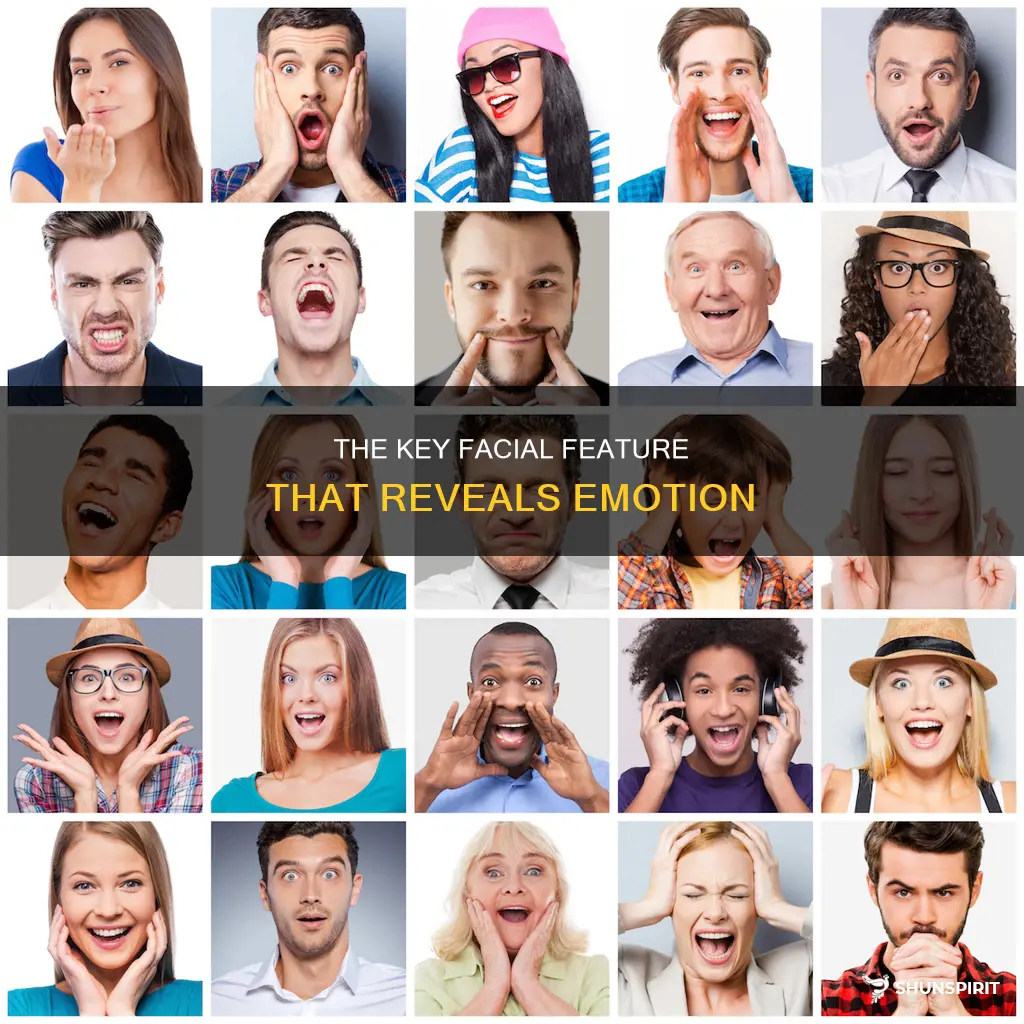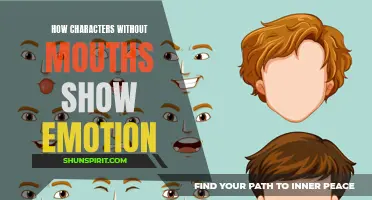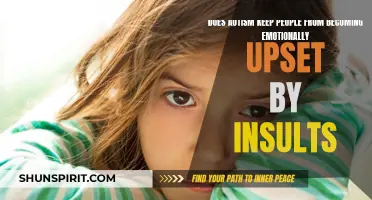
The human face is an incredibly expressive canvas, revealing a wide range of emotions with just a flicker of a muscle or shift in a feature. While our entire face plays a role in conveying emotions, it is often said that our eyes are the windows to the soul. However, researchers have also found that certain areas of the face, such as the eyebrows, mouth, and even the tiniest creases and lines, can speak volumes about how we are feeling. In this article, we will explore the fascinating world of facial expressions and dive into which part of the face truly shows our deepest emotions.
| Characteristics | Values |
|---|---|
| Eyebrows | Arched, raised, furrowed |
| Eyes | Wide, squinted, teary |
| Mouth | Smiling, frowning, pouting |
| Cheeks | Flushed, dimpled, drooping |
| Forehead | Wrinkled, smooth, raised |
| Nose | Flared, wrinkled, sniffling |
| Chin | Trembling, jutting, double chin |
What You'll Learn

Facial Expressions: The Key to Understanding Emotion
When it comes to understanding human emotion, facial expressions play a crucial role. Our faces are incredibly expressive, and they provide valuable information about our inner thoughts and feelings. By learning to interpret different facial expressions, you can gain a deeper understanding of the emotions that others are experiencing. In this article, we will explore the various parts of the face that show emotion and provide some tips on how to read them.
Eyes:
The eyes are often considered the window to the soul, and for a good reason. They reveal a wealth of information about how a person is feeling. For example, when someone is happy, their eyes will often crinkle at the corners, and their pupils may dilate slightly. On the other hand, when someone is sad, their eyes may appear watery or filled with tears. Additionally, the eyebrows also play a role in expressing emotion. When someone is surprised or concerned, their eyebrows may raise, while furrowed eyebrows may indicate anger or frustration.
Mouth:
The mouth is another essential part of the face that shows emotion. When someone is happy, their mouth will often form a smile, with the corners turned up and teeth possibly showing. Conversely, when someone is upset or angry, their mouth may become a thin line or turn downward at the corners. The mouth can also express other emotions such as fear, surprise, or disgust, depending on the specific shape it takes.
Forehead:
The forehead is a part of the face that can reveal a lot about a person's emotions. When someone is surprised or intrigued, their forehead may wrinkle, creating horizontal lines across the forehead. Conversely, when someone is angry or focused, vertical lines may appear between their eyebrows. These furrows can give you a good indication of the intensity of someone's emotions.
Cheeks:
The cheeks also play a role in expressing emotions, particularly when it comes to happiness. When someone is genuinely happy, their cheeks often elevate, causing the skin to tighten and create visible dimples or creases. These elevated cheeks can help differentiate a genuine smile from a forced or fake one.
Nose:
While the nose may not be as expressive as other facial features, it can still provide clues about a person's emotions. For example, when someone is disgusted or repulsed, their nose may wrinkle or scrunch up. This wrinkling of the nose can be a clear sign that someone is experiencing a negative emotion.
While these are just a few examples, it is essential to remember that everyone expresses emotions differently. Culture, personality, and individual differences can all influence how someone displays their emotions. Therefore, it's crucial to consider the context and use a holistic approach when interpreting facial expressions.
In conclusion, facial expressions are a powerful tool for understanding and interpreting human emotions. By paying attention to the eyes, mouth, forehead, cheeks, and nose, you can gain valuable insights into how someone is feeling. So, the next time you find yourself in a conversation, take a moment to observe and analyze the various parts of the face. You might be surprised by how much you can learn about someone just by paying attention to their facial expressions.
Identifying the Traits of an Emotionally Abusive Narcissist: Signs to Look Out For
You may want to see also

The Eyes: Windows to the Soul and Emotions
The eyes have long been referred to as the windows to the soul, and for good reason. They are not only our primary means of visual perception, but they also play a central role in expressing and conveying our emotions. In fact, the eyes are arguably the most expressive part of the face when it comes to displaying and reflecting our innermost feelings.
One of the ways in which the eyes convey emotion is through the movement of the eyebrows. When we are happy or surprised, our eyebrows tend to rise, creating an open and alert appearance. On the other hand, when we are sad or angry, our eyebrows typically lower and contract, making our expression appear more intense and focused. This simple movement of the eyebrows can communicate a wide range of emotions, from joy and surprise to sadness and anger.
Another crucial aspect of emotional expression in the eyes is the movement of the eyelids. More specifically, the opening and closing of the eyelids can convey a great deal about our emotional state. For instance, when we are excited or delighted, our eyelids tend to widen, making our eyes appear larger and more expressive. Conversely, when we are bored or disinterested, our eyelids may droop or partially close, giving us a more indifferent and unfocused look.
The size and shape of the pupils also play a significant role in expressing emotion through the eyes. When we are happy or excited, our pupils tend to dilate, making our eyes appear brighter and more vibrant. Conversely, when we are fearful or anxious, our pupils may constrict, making our eyes appear smaller and more focused. These changes in pupil size can be subtle, but they can have a profound impact on the overall expression and intensity of our emotions.
Lastly, the overall gaze of the eyes can convey a wealth of information about our emotional state. Eye contact, for example, is a fundamental aspect of human communication and can indicate interest, trust, or engagement. Avoiding eye contact, on the other hand, can suggest shyness, fear, or even deception. The direction of our gaze can also be revealing, as it can signal what we are paying attention to and where our focus lies.
In conclusion, the eyes are indeed the windows to the soul and serve as powerful tools for expressing and conveying our emotions. From the movement of the eyebrows and eyelids to the size and shape of the pupils, our eyes can reveal a wide range of feelings, from happiness and surprise to sadness and anger. By paying attention to these subtle cues, we can gain valuable insights into the emotional state of ourselves and others. So the next time you find yourself trying to understand someone's feelings, remember to look into their eyes, as they may be telling you more than words ever could.
How to Assert Yourself and Stand Up to an Emotional Abusive Boyfriend
You may want to see also

The Mouth: Expressing Emotion through Smiles, Frowns, and Pouts
The mouth is a crucial part of the face when it comes to expressing emotions. Our lips and the movements they make play a significant role in conveying how we feel, whether it's happiness, sadness, anger, or surprise. The mouth can communicate emotions in various ways, such as through smiles, frowns, and pouts. In this blog post, we will explore how the mouth expresses different emotions and what these expressions mean.
- Smiles: The universal symbol of happiness, a smile is a powerful expression that can uplift spirits and create a positive atmosphere. When we smile, our lips curl upwards, and the corners of our mouth pull back, revealing our teeth. A genuine smile involves the eyes, which also crinkle, creating what is known as a Duchenne smile. Smiling not only conveys joy but can also indicate friendliness, warmth, and approachability.
- Frowns: On the other end of the emotional spectrum, a frown represents sadness, dissatisfaction, or displeasure. When we frown, the corners of our mouth turn downwards, and our brows may become furrowed. Frowning can manifest as a slight downturn of the lips or a more intense expression, depending on the severity of the emotion being felt. Frowns often suggest that something is amiss and can indicate a need for comfort or understanding.
- Pouts: Pouting is a unique expression that commonly conveys a combination of sadness, frustration, and disappointment. When someone pouts, their lower lip pushes forward and slightly downwards, creating a protruding effect. The mouth appears like a small child who is unhappy or sulking. Pouting can be seen as a way of seeking attention or sympathy from others, expressing a desire for things to be different or to have one's needs met.
Aside from these primary expressions, the mouth also contributes to conveying other emotions. For example:
- Surprise: When someone is surprised, their mouth usually opens slightly, and the eyebrows lift. This expression of astonishment is often accompanied by widened eyes and can indicate excitement, shock, or disbelief.
- Disgust: The mouth can play a significant role in expressing disgust. A common sign of disgust is when the upper lip wrinkles, and the corners of the mouth turn downwards, creating a contorted and displeased expression.
- Anger: When angry, the mouth can tighten, and the lips may press together firmly. This can be seen as a sign of restraint, as if the person is preventing themselves from saying something in the heat of the moment. It can also be accompanied by other signs of anger, such as raised eyebrows or a furrowed forehead.
- Contempt: A subtle yet powerful expression, contempt involves a slight curl of the upper lip on one side, creating a lopsided and dismissive look. This expression is often associated with feelings of superiority or disdain towards someone or something.
Understanding how the mouth expresses emotions can be essential in effective communication. It allows us to interpret others' feelings and adjust our responses accordingly. Similarly, being aware of how our own mouth movements may convey emotions can help us express ourselves more effectively and connect with others on a deeper level.
Next time you interact with someone, pay close attention to the movements of their mouth. You might be surprised at how much you can learn about their emotions and how you can respond appropriately. Remember, the mouth is not just a means of verbal communication; it is also a gateway to understanding and connecting with others on an emotional level.
Understanding Emotional Child Neglect as Abuse in the State of Florida
You may want to see also

The Forehead: Furrowed Brows and Raised Eyebrows Revealing Emotion
When it comes to expressing emotion, our faces play a vital role. The various muscles and tissues in our face allow us to convey a wide range of feelings and attitudes, from happiness and surprise to sadness and anger.
One of the key areas that reveal our emotions is the forehead. Whether it's through furrowed brows or raised eyebrows, our forehead gives away a lot about what we're feeling. Let's take a closer look at how the forehead expresses different emotions:
Furrowed Brows: When we're feeling concerned, worried, or angry, our brows tend to furrow. This expression is characterized by vertical lines or creases forming on the forehead, just above our eyebrows. It conveys tension and shows others that something is bothering us. The deeper the furrows, the more intense the emotion.
To intentionally furrow your brows, start by relaxing your face and then gradually bring your eyebrows together. As you do this, imagine there's a line between them that you're trying to close. Practice furrowing your brows in front of a mirror to see how it changes your expression.
Raised Eyebrows: On the other hand, raising your eyebrows can convey surprise, disbelief, or curiosity. When we're genuinely amazed or puzzled, our eyebrows tend to move upward, causing the forehead to wrinkle horizontally. This expression is also commonly used to show interest or draw attention.
To raise your eyebrows naturally, imagine yourself being genuinely surprised or intrigued by something. Focus on lifting your eyebrows upward while keeping the rest of your face relaxed. Practice in front of a mirror to perfect this expression.
In addition to furrowed brows and raised eyebrows, the forehead also plays a supporting role in conveying other emotions. For example, when we're happy or excited, our forehead becomes smoother, and our eyebrows might even lift slightly. Conversely, when we're sad or disappointed, our forehead can become wrinkled vertically, adding depth to our expression.
It's worth noting that the forehead alone is not enough to accurately determine someone's emotions. To get a complete understanding, it's crucial to look at the entire face, including the eyes, mouth, and overall facial posture. Different combinations of facial expressions work together to create a more comprehensive picture of someone's emotional state.
In conclusion, the forehead, with its ability to furrow brows or raise eyebrows, is a significant indicator of emotion. Practicing and becoming familiar with these expressions can help us better understand and interpret the emotions of others. So, next time you're having a conversation or observing someone, pay attention to their forehead and let it guide you in deciphering their feelings. Remember to use this knowledge responsibly and respectfully in social interactions.
Tips to Save Your Marriage After an Emotional Affair
You may want to see also







